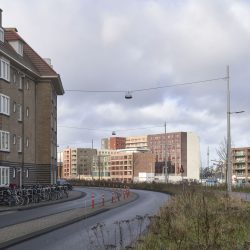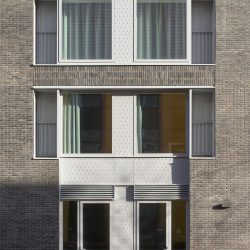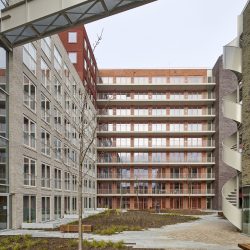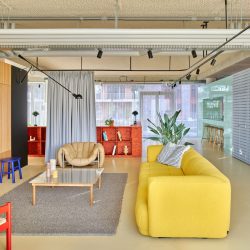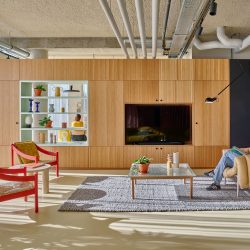
Domūs Houthaven is a residential ensemble featuring 235 smart compact apartments and an array of shared facilities on a plinth of commercial spaces The complex is designed as a family of interconnected blocks surrounding a raised communal courtyard. The interconnectedness and the generous collective facilities encourage interaction among residents. In Domus, you live alone, or as a couple, without being alone.
The compact apartments ranging between 43 and 60m2 are surprisingly spacious due to the smart living core that incorporates, besides kitchen, bathroom, storage and installations, an alcove bed.
The ensemble forms the keystone of the superblock on the northwest edge of Amsterdam’s Houthaven, which is in the process of being developed into a new residential neighborhood.
Domūs Living
Domūs Houthaven is the first realization of Domūs Living, an innovative urban concept developed by Shift, Synchroon and …,staat creative agency. Domūs Living combines compact apartments with the benefits of shared amenities, public services and a community nearby. It enables sustainable high-density residential buildings that use space, energy and materials efficiently. The concept targets the growing group of one- and two-persons households that put social contacts and experiences above ownership. They are open to different forms of sharing, not only because it is sustainable, but also because it is fun and valuable. For example, because it prevents loneliness. Domūs responds as well to the growing group of people who like to work “from home not from home”.
Unity in diversity
The volumetric design of the project follows the principle of unity in diversity. The individual blocks – with their own grain size, facade rhythm and color- feature distinct apartment typologies and access. This differentiation enables identification with one’s own home within the large-scale complex and reduces the project to a scale consistent with the characteristic grain size of the new urban district.
To strengthen the cohesion between the different building volumes, they share the same architectural DNA. The choice of rational brick volumes with generous facade openings and robust detailing refers to the industrial character of the harbor area. Each building volume has its own masonry grid with varying depths of recesses. These grids bring together mass and transparency in such a way that daylight, views and privacy are tailored to the specific type of apartment per block.
Connecting circulation space
The building volumes are visually separated and at the same time physically connected by a common circulation space. Placing the blocks slightly apart from each other creates entrances and corridors with plenty of daylight. Not only do they connect all the dwellings, they also open up a range of communal facilities as well as the communal garden for all residents. Placing two blocks further apart on the south side creates an opening that provides the garden with sunlight and views. To maintain connectedness within the ensemble, the gap is bridged by an aerial bridge on the fifth floor.
Communal facilities
The communal facilities are geared toward various forms of everyday use. All residents have access to a multifunctional work- and livingroom next to the communal garden and a spacious cooking studio with roof terrace on the fifth floor. The work- and livingroom forms the social heart of the residential ensemble. The space is open and flexible in character and at the same time homely. Shift designed four large free-standing pieces of furniture that function as room dividers. They create different places and allow multiple activities simultaneously without affecting the continuity of the space. People work, eat, play and hang out. In addition, both large and small group activities take place. The integration of a laundromat and the manager’s office bring additional hustle and bustle.
The roof pavilion, accessible via the air bridge, houses a cooking studio and a guesthouse. The cooking studio is designed as a glass house with an unobstructed view of the Spaarndammer neighborhood. It is equipped with a professional cooking island and seating for groups both inside and outside on the roof terrace. The guest room is equipped with a bathroom allowing residents to have their guests stay here independently. In the belly of the building, under the communal garden, is a generous bike shed for nearly 500 bikes and a double-level parking garage with 70 parking spaces including 5 for shared cars.
Smart living core with alcove bed
All apartments offer a high degree of spaciousness and flexibility, despite their compact area of between 43 and 60m2. They all contain a smart living core consisting of a configuration of modules for (open) kitchen, bathroom, closet space and alcove bed. In this way, the remaining space, the actual living space, is maximized both in size and in terms of use. Each module of the smart core has its own color. This gives the furniture a sculptural effect that underlines and enhances the specific character of each apartment type. The polychrome furniture piece contrasts with the concrete ceiling that has been left untreated.
The alcove bed frees the home from a bedroom without becoming a regular studio apartment where you actually live in your bedroom. When the alcove doors are closed, you have one large living space. Once the perforated doors of the alcove are open, the space transforms into one large bedroom. Such a solution makes use of the fact that the privacy offered by a separate bedroom is not an issue in single-person households or cohabiting couples.
Operator
In addition to the physical communal facilities, Domūs Houthaven pays close attention to its programmatic side. This is handled by an operator who manages the common areas and encourages contact between residents. The facility manager is there every day to answer questions and pick up tasks. The community manager himself lives in the building. He helps fellow residents to organize
activities.
Connection to the neighborhood
The plinth of the ensemble seeks to connect with the neighborhood by providing spaces for public amenities. The first functions to appear here soon will be a gym, a daycare center and a Domus café. This café is connected to the collective work- and livingroom and establishes a symbiotic relationship with it.
_
Client: Synchroon developers
Architect: Shift architecture urbanism. Team: Oana Rades, Thijs van Bijsterveldt, Harm Timmermans, Marinda Verschoor, Philip de Klerk, Martina Drys, Elise Osterloo, Paul Voorbergen
Landscape design: Flux landscape architecture
Contractor: Van Wijnen Haarlemmermeer
Contractor Interior: Blom interieurs
Structural engineers: ABT (odesign phase) & Vericon (realization phase)
MEP and acoustic: ABT
Construction drawings: LMV bouwkundig adviesbureau
Branding identity: …,staat Amsterdam
Photography: René de Wit, Pim Top
Various interior pieces Studio Michael Schoner, Studio Earnestly, Odd Matter
Owner CBRE Global Investors
Operator TO BE AT

